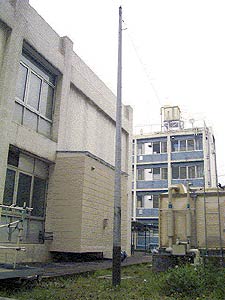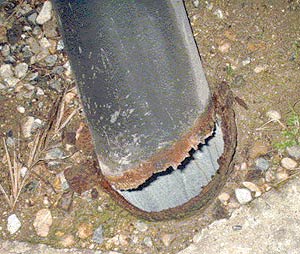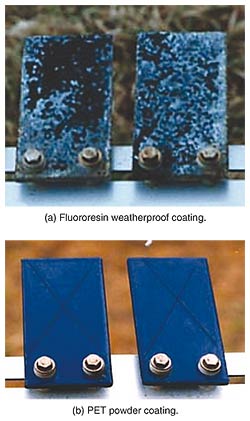 |
|||||
|
|
|||||
|
Special Feature on Technical Solutions to Real-world Problems Vol. 5, No. 7, pp. 5–7, July 2007. https://doi.org/10.53829/ntr200707sf1 Environmentally Friendly "Eco Steel Telephone Pole"AbstractAn environmentally friendly "eco steel telephone pole" featuring greatly improved endurance and weather resistance compared with conventional steel telephone poles has been developed. This new pole satisfies the environmental 3Rs (reduce, reuse, recycle), and its long life will reduce the life-cycle environmental load and cost significantly and enable maintenance-free operations.
1. Steel telephone poles and corrosionNTT manages several million steel telephone poles throughout Japan that support both telephone and broadband services. At the time of installation, the bottom of a steel telephone pole is buried in the ground, but this underground environment contains corrosion-promoting factors such as moisture, oxygen (air), and salt, making it especially easy for the pole to deteriorate over time. In addition, the part of the pole that comes into contact with the ground surface undergoes repeated wet-and-dry cycles, so it is particularly vulnerable to corrosion. How to solve this problem of corrosion has consequently become an issue in achieving long-life steel telephone poles and making more effective use of facilities. A robust corrosion-resistant coating has come to be desired. 2. Problems with conventional steel telephone polesConventional steel telephone poles (Photo 1) are given a corrosion-resistant coating of tar epoxy resin. This is applied to the lower portion of the pole extending from 50 cm above the surface to the bottom of the pole under the ground. However, this coating material includes coal tar, which is a known human carcinogen, so there is a demand for an alternative material.
There have also been cases in which steel telephone poles installed in locations having overlapping corrosion-inducing environments—such as seaside areas having very moist soil with poor drainage and little sunshine—have experienced accelerated corrosion, resulting in breakdown earlier than the estimated lifetime (Photo 2).
When steel telephone poles are installed in a large number for use over a long period of time, individual poles must be replaced if necessary. However, the labor required for maintenance inspections to determine that need is not trivial. Corrosion can occur at many locations on the pole, including those at surface level and underground. This makes facility inspections difficult. Furthermore, there are various expenses associated with replacing a pole such as the costs of purchasing a new pole, removing the old one, and installing the new one. These operations also require natural resources and energy, which increase the increasing environmental load. 3. PET powder coating as a solutionConsidering the above background, NTT investigated a solution that would not simply remove toxins but would also transform its environmental policies. First, placing emphasis on long life, we decided to use a PET (polyethylene terephthalate) powder coating developed by NTT Technical Assistance & Support Center. PET is an economical general-purpose resin used for making beverage containers and is a major target of recycling efforts. PET powder coating exhibits high corrosion-resistant performance. In the manufacture of an eco steel telephone pole, finely pulverized PET powder is applied to the surface of a heated steel pole (galvanized steel). The powder material melts, forming a coat (Photo 3). We found that the important factors in obtaining a good coat were material composition, pole-surface processing, and temperature control. We also found that the PET should be configured with an appropriate distribution of crystalline and non-crystalline structures. The high melting temperature of PET was also an issue, and controlling the temperature of a large item like a steel telephone pole was extremely difficult. We therefore gathered together techniques for dealing with these problems and succeeded in forming a tough coat with no fine pinholes. This new PET powder coating has so far been applied to underground structures and steel telephone poles for special applications (such as those used in areas conducive to electrical corrosion and salt erosion). Recent research has enhanced the powder material and significantly improved its weather resistance.
4. Features of the eco steel telephone poleThe eco steel telephone pole (Photo 4) satisfies the environmental 3Rs (reduce, reuse, recycle) [1].
(1) Reduce: When considering the provision of long-term service corresponding to facility lifetime, a significant extension of lifetime beyond that of conventional steel telephone poles can greatly reduce the amount of natural resources and energy required. Implementing the new steel telephone pole is estimated to be equivalent to reducing carbon dioxide emissions by more than 10,000 tons per year. (2) Reuse: When this tough and long-life coating made from PET powder is used, a steel telephone pole that must be removed for some reason can be reused at another location. (3) Recycle: Because the telephone poles themselves are made of steel, they can be treated as a high-quality reclaimable resource at the time of disposal. The PET power coating can be made from material recycled from PET bottles. The eco steel telephone pole also satisfies the original objective of eliminating a toxic substance (coal tar). Furthermore, it does not require any organic solvent in the manufacturing (coating) process, which ensures there is no release of such chemicals into the atmosphere. This is beneficial because the organic solvent in question is also toxic and promotes photochemical smog. 5. Future plansAfter assessing the need for this coating technology in outdoor facilities located in high-corrosion environments, we will propose its application on a step-by-step basis. We will also promote the expansion of this technology in society by reducing the material and processing costs and the service operation cost through the advantages of mass-production. References
|
|||||











